Engagement Ring - In Progress
Setting
Stone
Limited Time! Purchase any Engagement Ring and Receive a $250 Gift Card & Premier VIP Bundle.
We guarantee that every single purchase directly impacts one person's life by giving them access to clean water.
Don’t: Amethyst, Opal, Pearl, Tanzanite, Morganite, Moss Agate
A gemstone engagement ring is a type of engagement ring that has a non-diamond center stone. Often designed using traditional engagement settings such as solitaires, halos, and three-stones, some couples choose less traditional settings to hold their less traditional center stone. Common gemstone choices include Sapphire, Emerald, and Ruby. Aquamarine engagement rings, Morganite engagement rings, Tanzanite engagement rings, Opal engagement rings, Moss Agate engagement rings, and Amethyst engagement rings are gaining popularity too. However, some of these stones will not stand up to daily wear.
There are many benefits to choosing a gemstone engagement ring, including personality, uniqueness, and cost. Learning the risks associated with choosing a gemstone over a diamond will help couples better care for their gemstone engagement ring, and feel confident in their choice.
Couples choose gemstone engagement rings for many reasons. Some like to express themselves in color. A bright red ruby engagement ring says passion. A dark blue sapphire engagement ring stands for loyalty. Couples love splashy oranges and pinks, and cool fresh greens. Gemstones are lively!
Another reason to consider a gemstone engagement ring is cost. Depending upon the stone, size, and color, gemstones are often a fraction of the cost of a similarly sized diamond. So, couples choosing a gemstone engagement ring can often afford a larger center stone in gemstone than in diamond.
Speaking of size, many gemstones regularly grow in large crystals. As a result, many gemstones are available in sizes and shapes that diamond is not. So, couples have the opportunity to choose large, fancy shapes for their special ring.
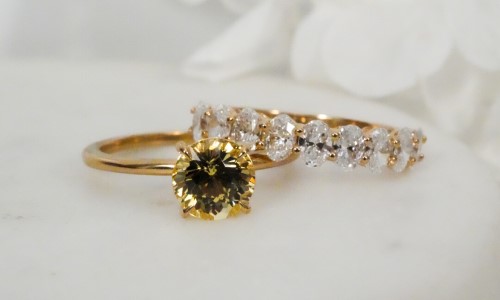
Yellow Sapphire Engagement Ring
While there are many benefits to gemstone engagement rings, there are risks to consider before purchase too. Because gemstones are not as hard as diamond, gemstone engagement rings may scratch or chip more easily. Couples can protect against this by choosing a hard gemstone, and by designing a protective setting.
Another issue to be aware of is that gemstones’ unique colors and shapes can be more difficult to replace in the event of loss or breakage. Because gemstones are often cut in less standard shapes than diamonds, couples may have a harder time finding the exact measurements of their original stone. Likewise, as gemstone color is so unique – consider all the various shades of “blue” at the paint store – finding the exact color you originally had can be tough. Couples can protect themselves by having a gemologist appraise and color grade their gemstone so they have an exact record.
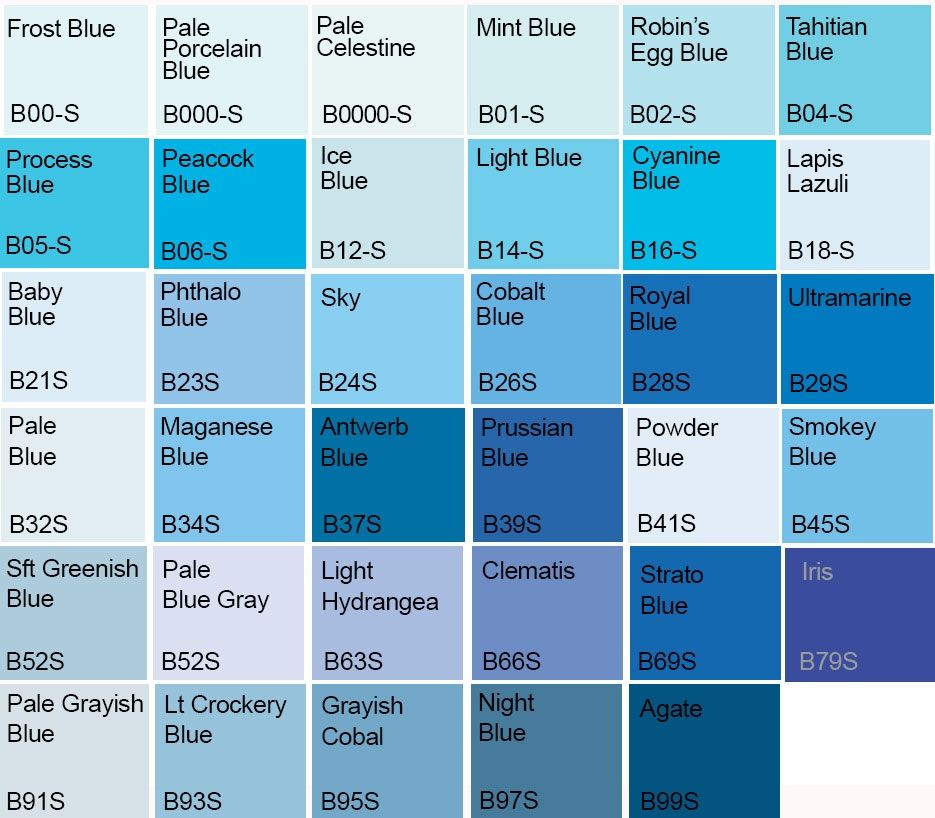
Shades of Blue, from Copic Markers
Some gemstones are – and some aren’t. One of the reasons you’ll hear a “diamond is forever” is because diamonds are a 10/10 on the Mohs Hardness Scale. This means that diamond is (literally) the hardest substance known to man. There is nothing that can scratch at diamond except for, you guessed it, another diamond. Non-diamond gemstones are not as hard. However, neither is the glass on your car’s windshield, the screen on your iPhone, or the table you’re sitting at right now. In other words, there’s still some pretty durable stuff out there. Let’s talk about how hard a gem needs to be in order to stand up to daily wear.
The Mohs Hardness Scale was developed to rank the hardness of gemstones and minerals. It goes from 1 (Talc) to 10 (Diamond). This is useful when trying to select a gemstone engagement ring center stone, because we know how hard daily life is. Huh? No seriously, hear me out.
You know, the stuff floating around in the air? That’s the stuff that will scratch your gemstone when you try to clean it. So, when choosing a gemstone engagement ring, your best bet is to choose a gemstone of 7.5/10 and above. The closer to 10/10 you get, the more durable your ring will be.
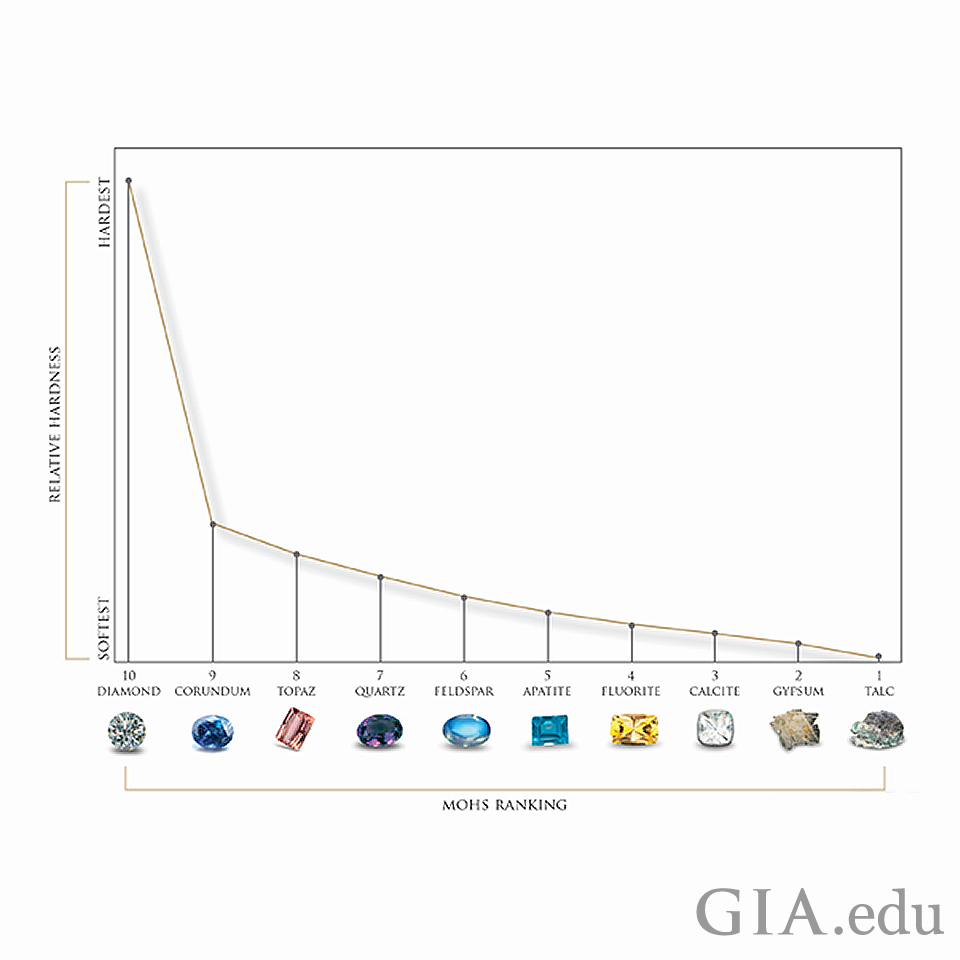
Mohs Hardness Scale. (Photo by: GIA)
Gemstones of a 7.5/10 on the Mohs Hardness Scale and above make the best engagement ring center stones. My own Spinel is an 8/10, and I still treat it very gingerly (and love it very much!) Let’s review some durable gemstone engagement ring options, in order of hardness:
Emerald is a beautiful, mystical green. It is durable, at a 7.5/10 on the Mohs Hardness Scale. Its name derives from Sanskrit, and it symbolizes growth and energy. Emerald comes in many shades, including pure green, yellow-green, and blueish-Green. It can be light or dark. As a Type III gemstone, Emerald often shows extensive eye-visible inclusions. In other words, don’t expect an Emerald to be flawless. Some people call an Emerald’s inclusions its “garden.” Couples choosing an Emerald engagement ring should take caution that inclusions which reach the surface of the gem may increase its risk for chipping. So, watch out for large inclusions which meet the edges of your stone. Also, make sure to choose an emerald engagement ring setting that protects any inclusions which may put the ring at risk.

Emerald Engagement Ring
Aquamarine is a shiny, light blue gem that symbolizes tranquility and healing. Unlike its sister, Emerald, Aquamarine is a Type I gem, meaning it should be pretty flawless. Like Emerald, it is a 7.5/10 on the Hardness Scale. Aquas can come in light, medium, and darker blue tones. It sometimes shows a hint of green, like the sea. Couples choosing an Aquamarine engagement ring should look for an eye-clean gem that shows its blue color. Lighter blues are less valuable than medium or medium-dark blues. Darker color blues will also help to hide when your Aquamarine engagement ring is not sparkling clean, whereas light blue shows dirt and oil much more easily.
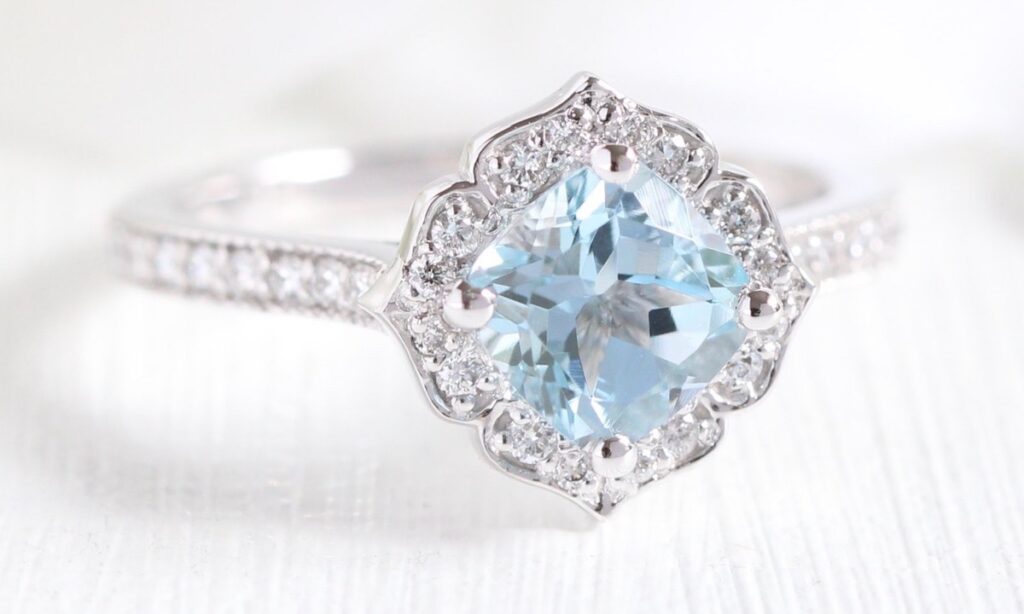
Aquamarine engagement ring. (Photo by: La More Design)
Topaz is an 8/10 on the Mohs Hardness Scale, making it a good engagement ring option. It symbolizes wealth and royalty. The most common color of Topaz today is blue, however it is also naturally found in colorless, pink, yellow, and peach hues. Blue Topaz comes in some massive crystals, making it a great choice for couples that want a huge look. When choosing a Topaz engagement ring, you should look for an eye clean stone with medium color.
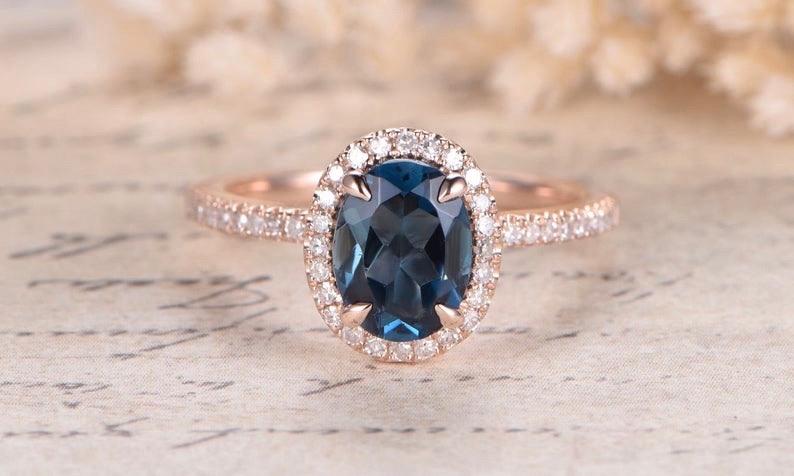
Topaz engagement ring.
My engagement ring is a Spinel! Although it is not commonly heard of, Spinel makes a good engagement ring choice due to its 8/10 hardness on the Mohs Scale and its vast array of colors. Spinel symbolizes power and protection. My Spinel is a blueish-Violet color, but I have also designed Spinel engagement rings in bright Pink and Black. The most sought after colors in this gemstone engagement ring are red, pink, and blue, as they can rival Ruby and Sapphire. Spinel is a Type II gemstone, which means they often have some inclusions, but can also be eye-clean. So, couples choosing a Spinel should look for an eye-clean stone in a color that speaks to them!
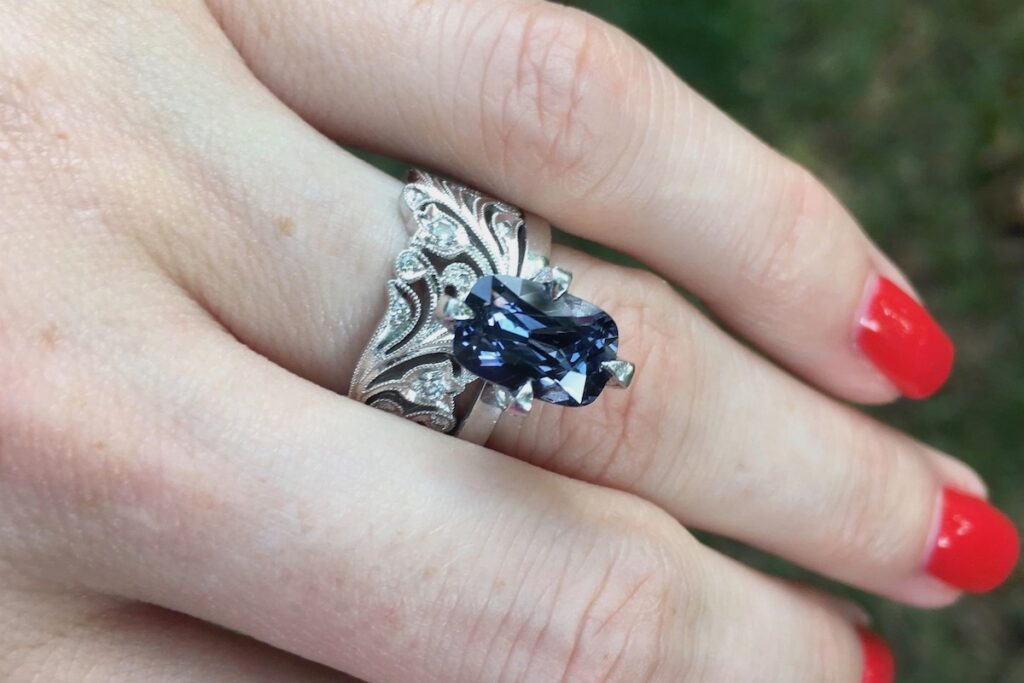
2.75ct Cushion Spinel Engagement ring.
Alexandrite is a great choice for an engagement ring due to its 8.5/10 Mohs hardness. It is the color-change version of the larger gem group Chrysoberyl, and symbolizes luck and balance. Alexandrite changes from green in daylight to red under a light bulb. Non-alexandrite Chrysoberyl comes in yellow, bronze, and green. Chrysoberyl symbolizes protection and healing. Chrysoberyl and Alexandrite are Type II gemstones, meaning they will have some inclusions, but eye-clean gems are available. So, couples choosing this engagement ring should look for eye clean gems.
When looking for an Alexandrite engagement ring, the most important thing to consider is the quality of its colors and color change. Couples looking for a Chrysoberyl engagement ring should seek out a pleasing, warm color.
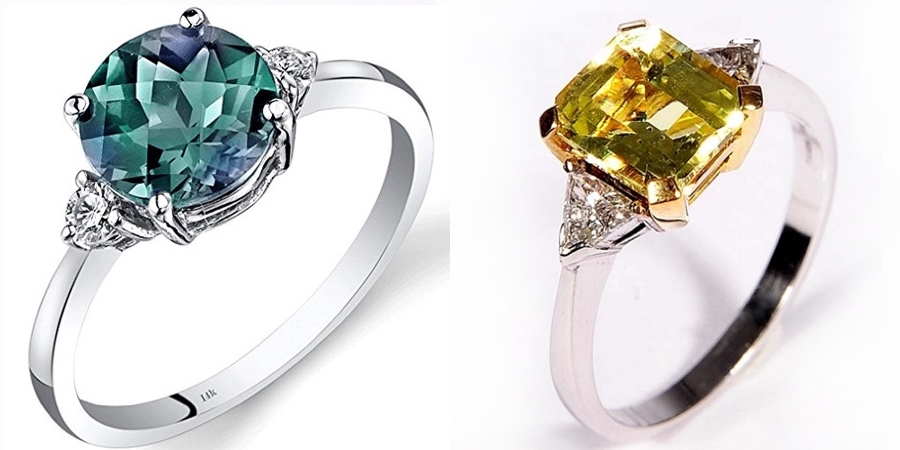
Left: Alexandrite engagement ring. | Right: Chrysoberyl engagement ring.
Sapphire and its sister, Ruby, are the hardest non-diamond gems available at a 9/10 on the Mohs Hardness Scale. Members of the gem family Corundum, red gems are Ruby, and all the other rainbow colors are Sapphire. A Sapphire engagement ring signifies loyalty. A Ruby engagement ring symbolizes love and passion. Sapphire and Ruby are Type II gems, meaning they will have some inclusions, but eye clean gems should be sought out. Rich medium tones (in other words, not too light and not too dark) are the most beautiful and valuable. Because of its superior hardness and crazy amount of colors, a Sapphire engagement ring is an excellent gemstone engagement ring choice. Likewise, due to its romantic color and great durability, couples looking for something different should definitely consider a Ruby engagement ring.
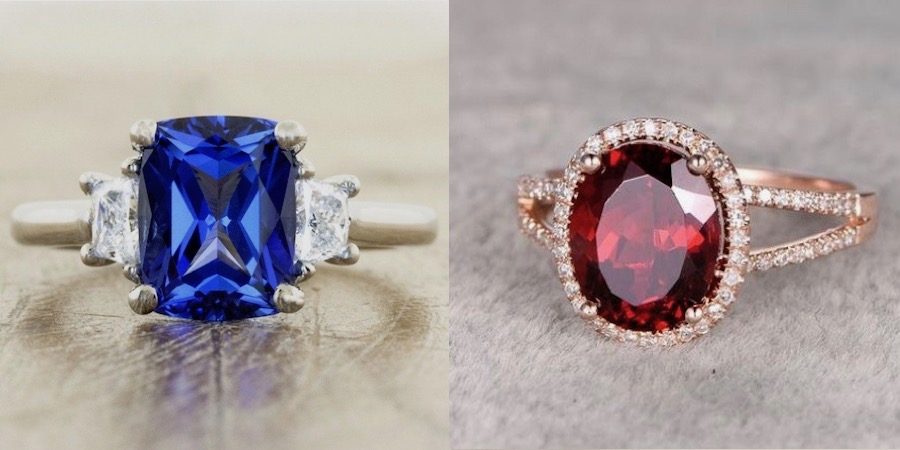
Left: Sapphire engagement ring. | Right: Ruby engagement ring.
Opals are beautiful shimmery gems that are very, very soft. A 5.5-6.5 on the Mohs Hardness Scale, in fact. So, even with extreme caution, there is a real chance the gem will break during normal wear. As a result, Opal engagement rings are not ideal. Instead, couples looking for an Opal engagement ring should check out Star Sapphire – much harder and just as unique!
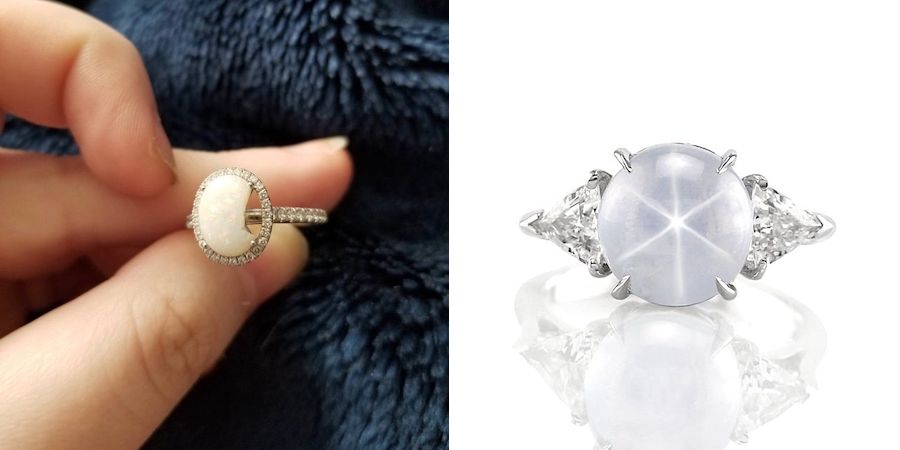
Left: Chipped Opal center stone. | White star sapphire engagement ring.
Morganite is a peachy-pink gem that is typically eye clean. It symbolizes love and innocence. This may sound like an ideal engagement ring choice, but real life gets in the way. Because of its light color and lack of significant sparkle, Morganite shows dirt and oil almost immediately. Even people who take great care of their rings will experience this, because, well, life. You have oil on your skin, put on makeup, use hairspray, wash your hands. So, instead of choosing a Morganite engagement ring, couples should check out Pink Topaz, Pink Spinel, or Pink Sapphire – much harder, and do not show dirt and oil as easily!
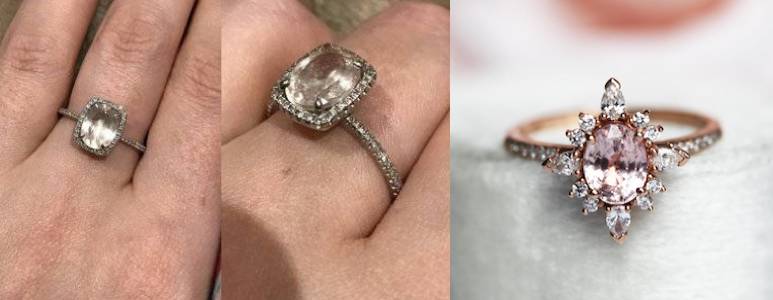
Left: Dull, dirty Morganite engagement ring. | Right: Pink sapphire engagement ring.
Pearl engagement rings are romantic. Unfortunately, they are also too soft, at a 2.5-4.5 on the Mohs Hardness Scale. Normal damage we see to Pearl engagement rings include loss of the pearl, dull spots where the nacre has worn off, and chipping. This is tragic! Instead, couples looking for a Pearl engagement ring should consider a white cabochon Sapphire instead. A sapphire engagement ring is much harder, and will last the test of time.
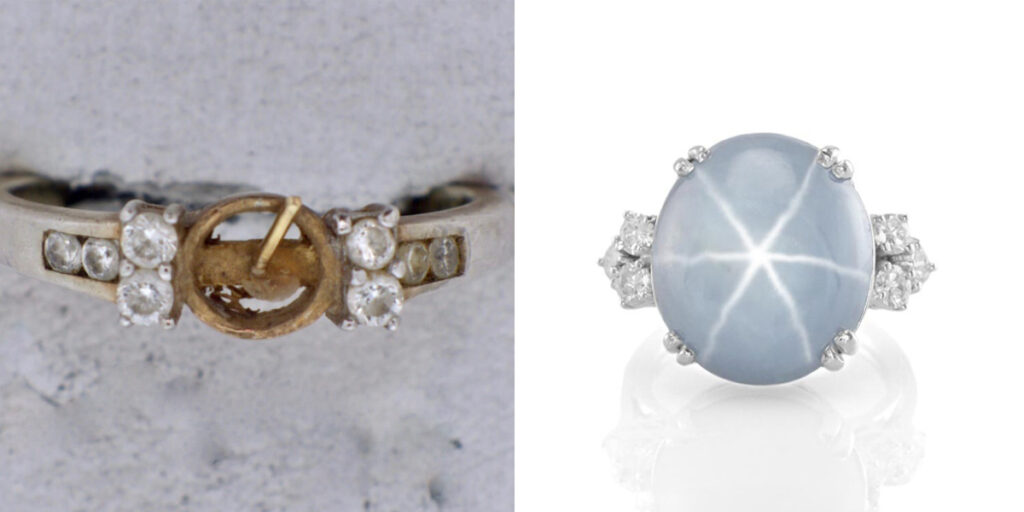
Left: Missing pearl in ring setting. (Photo by: MyJewelryRepair) | Right: Cabochon Sapphire engagement ring.
Amethyst is a rich, Welch’s grape purple that people adore for a unique engagement ring. Sadly, at a 7/10 on the Mohs Hardness Scale, Amethyst is the same hardness as dust. As a result, Amethyst will wear poorly over time, experiencing mini scratches until it is dull. That’s not what you want for an engagement ring! Instead, couples searching for an Amethyst engagement ring should check out Purple Sapphire which is much harder and will always be beautiful.
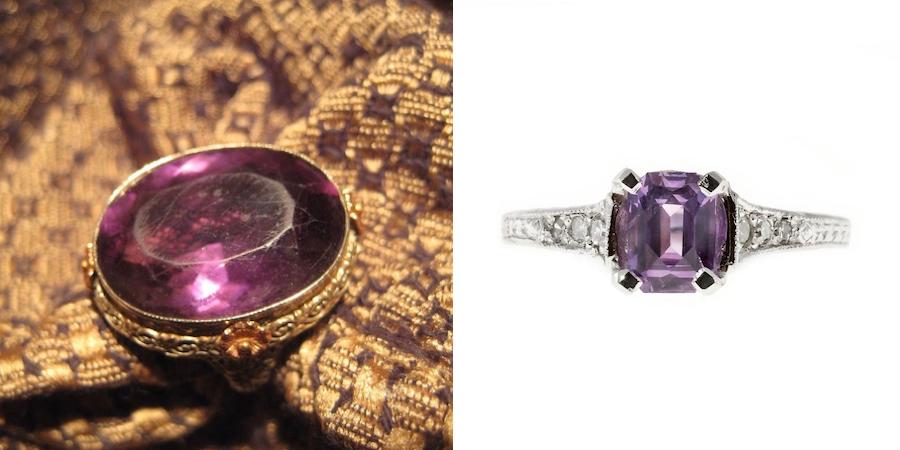
Left: Scratched Amethyst stone. | Right: Purple sapphire engagement ring.
Tanzanite burst onto the scene in 1967, and suddenly everyone wanted a Tanzanite engagement ring. It’s no wonder – it’s a gorgeous blue-violet that is quite uncommon in gems. However, at 6-6.5/10 on the Mohs Hardness Scale, it’s a bad idea for an engagement ring. Instead, couples looking for a Tanzanite engagement ring should look for Violet Spinel (like mine!). Spinel is much harder than Tanzanite and will hold up to daily wear much better.
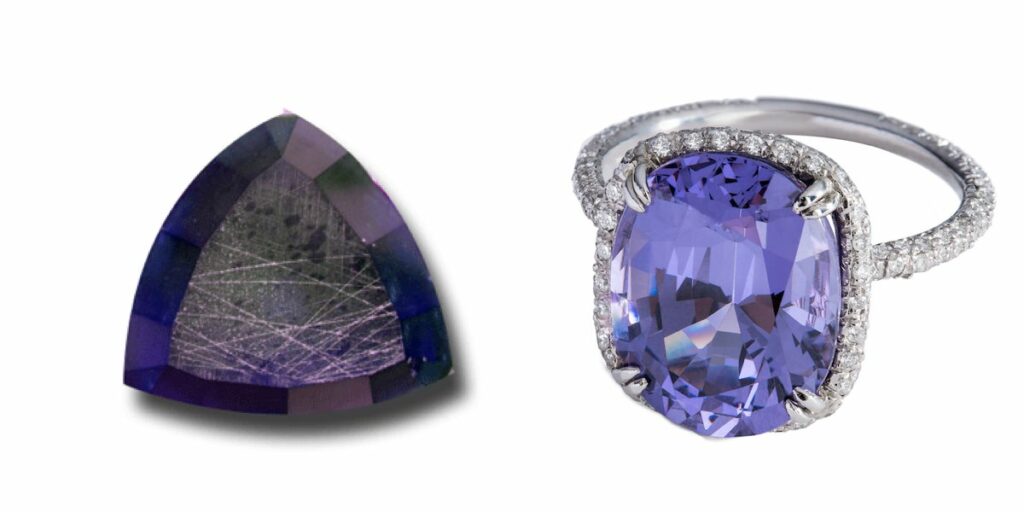
Left: Scratched Tanzanite gemstone. | Right: Violet Spinel engagement ring.
Moss Agate is a unique gemstone with organic, leaf-like inclusions. This kind of appearance is very popular with those who feel a connection with nature! Unfortunately, however, moss agate is a variety of quartz, meaning it is only a 7/10 on the hardness scale. This means it is risk for scratching, chipping, and generally becoming dull, like the ring below. We have helped many couples replace an original moss agate engagement ring that has sadly broken. Most of these couples opt for emerald or a unique green sapphire! Sapphire is a 9/10 hardness and comes in a ton of beautiful green shades – and it can even have great inclusions, reminiscent of moss agate. Nature-loving couples may also love emerald’s mossy “jardin” appearance – which actually means garden in French!
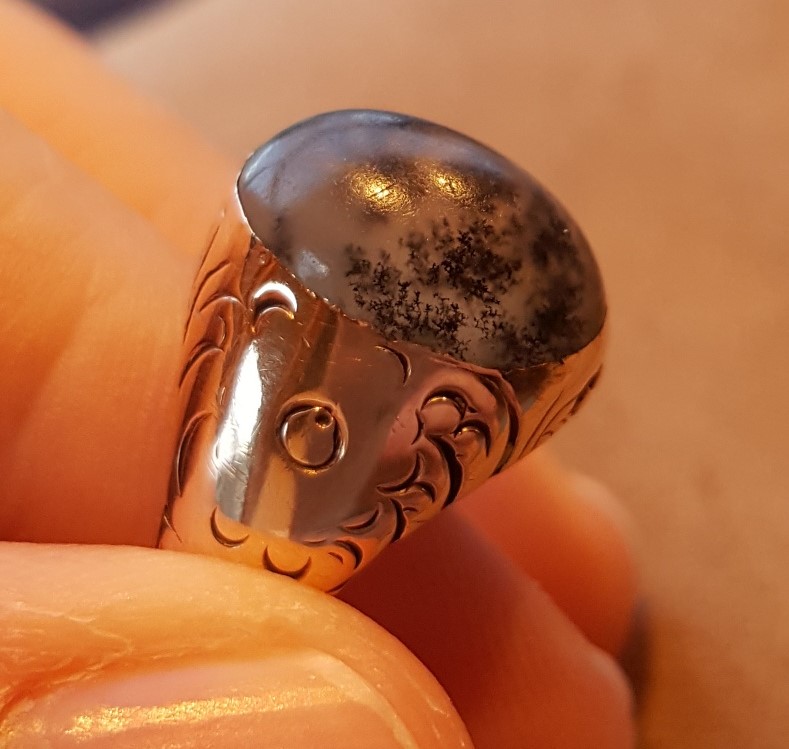
Scratched moss agate ring. Photo by spartcom5 on Antiquers.
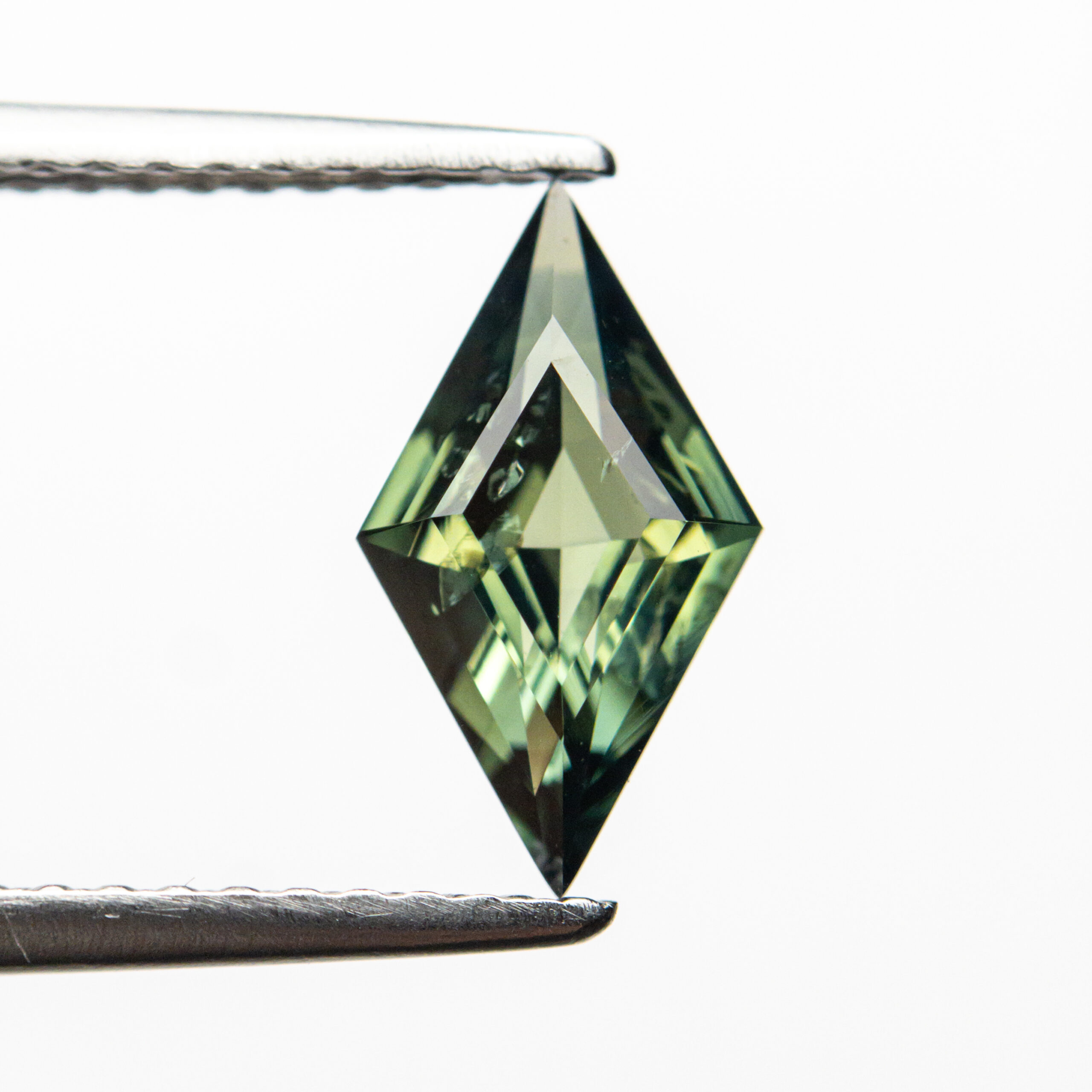
Natural green sapphire ring with lily-pad like inclusions.
I’d love to! Contact me here and describe the delicious color you’re looking for! I will walk you through what gemstone options are the most durable and find the perfect stone for you.
Verifiably Ethical & Sustainable
Guaranteed 1:1 Impact
Personalized 1:1 Customer Service
handcrafted & american-made
you before us, always
Verifiably Ethical & Sustainable
Guaranteed 1:1 Impact
Personalized 1:1 Customer Service
handcrafted & american-made
you before us, always
Thoughtfully crafted, made to last, and designed for life's most meaningful moments. LEARN MORE
Diamonds, Gemstones, & Metals
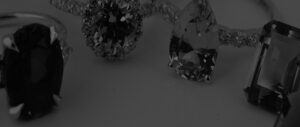
Every piece of Do Amore jewelry begins by not hurting the world. All our natural diamonds are either ethically sourced in Canada, recycled to eliminate additional demand, or accompanied by a blockchain ledger showing every hand your diamond passed through, proving your stone is truly conflict-free.
We also offer sustainable lab-created stones and guarantee all precious metals are recycled to eliminate the environmental impact of mining. Since March 2022, we carry absolutely no Russian diamonds and continue to urge the industry to follow suit.
Clean Water
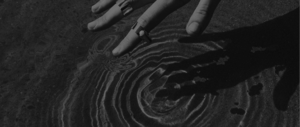
We desire to deepen the well of love in the world. We guarantee that every single purchase—whether engagement ring, wedding band, or piece of jewelry—directly impacts one person’s life by giving them access to clean water.
We do this by directly matching jewelry purchases to people in communities to ensure our funding has a one-to-one impact. We also show you the exact GPS coordinates and a photo of the water well your ring or piece of jewelry helped fund.
Customer Service
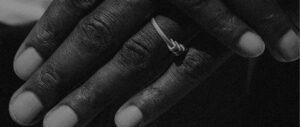
As a small, 100% founder- and employee-owned team, one-to-one encounters are at the heart of our values. Whichever way you want support throughout your engagement ring or jewelry purchase process, our team is here to accommodate you.
From high-touch to hands-off, video calls to text messages, you have our dedicated, responsive team on your side from the moment you start your search, to the day your well is built, to the time we meet again.
Engagement Rings, Bands, & Jewelry
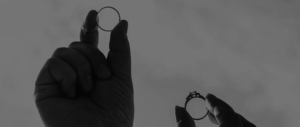
Every Do Amore design, whether one of our own or unique to you, is beautifully handcrafted in America and made specifically for you. Each ring is made to order, every time.
From classic to custom, you have the option to select from dozens of gorgeous settings or work with our design team to create something entirely bespoke. Plus, you are always covered for free inspections, polishing, cleaning, stone tightening, rhodium-plating, and resizing for life.
Our Promise

We care about what matters most to you, not what’s easiest for us. If it’s a minor change to a setting or arriving at a completely custom design, we work to ensure you get precisely what you love.
From statement-making to understated, we have options at any price point. Plus, you always have our team on your side searching to bring you every stone within your specifications. We also offer 60-day returns and a limited lifetime warranty to cover you in the rare event of a manufacturing defect.